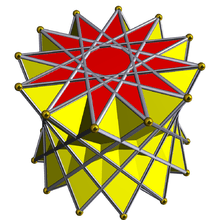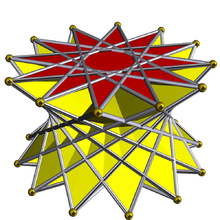Dodecagram
| Regular dodecagram | |
|---|---|
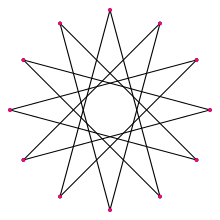 A regular dodecagram | |
| Type | Regular star polygon |
| Edges and vertices | 12 |
| Schläfli symbol |
{12/5} t{6/5} |
| Coxeter diagram |
|
| Symmetry group | Dihedral (D12) |
| Internal angle (degrees) | 30° |
| Dual polygon | self |
| Properties | star, cyclic, equilateral, isogonal, isotoxal |
A dodecagram is a star polygon that has 12 vertices. There is one regular form: {12/5}. A regular dodecagram has the same vertex arrangement as a regular dodecagon, which may be regarded as {12/1}.
The name "dodecagram" combines the numeral prefix dodeca- with the Greek suffix -gram. The -gram suffix derives from γραμμῆς (grammēs), which denotes a line.[1]
Isogonal variations
A regular dodecagram can be seen as a quasitruncated hexagon, t{6/5}={12/5}. Other isogonal (vertex-transitive) variations with equally spaced vertices can be constructed with two edge lengths.
 t{6} |
 |
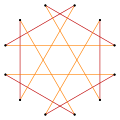 |
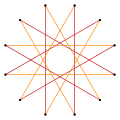 t{6/5}={12/5} |
Dodecagrams as compounds
There are four regular dodecagram star figures: {12/2}=2{6}, {12/3}=3{4}, {12/4}=4{3}, and {12/6}=6{2}. The first is a compound of two hexagons, the second is a compound of three squares, the third is a compound of four triangles, and the fourth is a compound of six straight-sided digons. The last two can be considered compounds of two hexagrams and the last as three tetragrams.
.svg.png) 2{6} |
.svg.png) 3{4} |
.svg.png) 4{3} |
.svg.png) 6{2} |
Complete graph
Superimposing all the dodecagons and dodecagrams on each other – including the degenerate compound of six digons (line segments), {12/6} – produces the complete graph K12.

Regular dodecagrams in polyhedra
Dodecagrams can also be incorporated into uniform polyhedra. Below are the three prismatic uniform polyhedra containing regular dodecagrams (there are no other dodecagram-containing uniform polyhedra).
Dodecagrams can also be incorporated into star tessellations of the Euclidean plane.
See also
References
- Weisstein, Eric W. "Dodecagram". MathWorld.
- Grünbaum, B. and G.C. Shephard; Tilings and Patterns, New York: W. H. Freeman & Co., (1987), ISBN 0-7167-1193-1.
- Grünbaum, B.; Polyhedra with Hollow Faces, Proc of NATO-ASI Conference on Polytopes ... etc. (Toronto 1993), ed T. Bisztriczky et al., Kluwer Academic (1994) pp. 43–70.
- John H. Conway, Heidi Burgiel, Chaim Goodman-Strass, The Symmetries of Things 2008, ISBN 978-1-56881-220-5 (Chapter 26. pp. 404: Regular star-polytopes Dimension 2)

